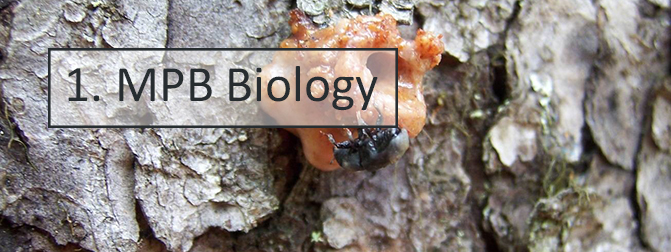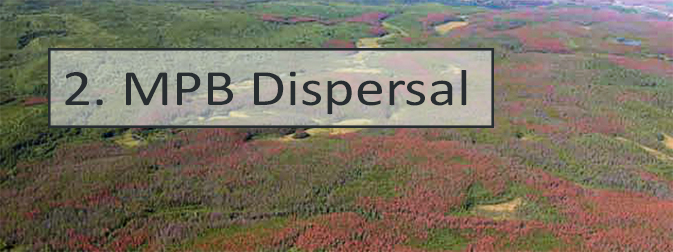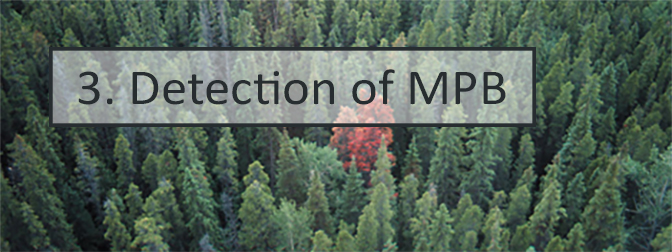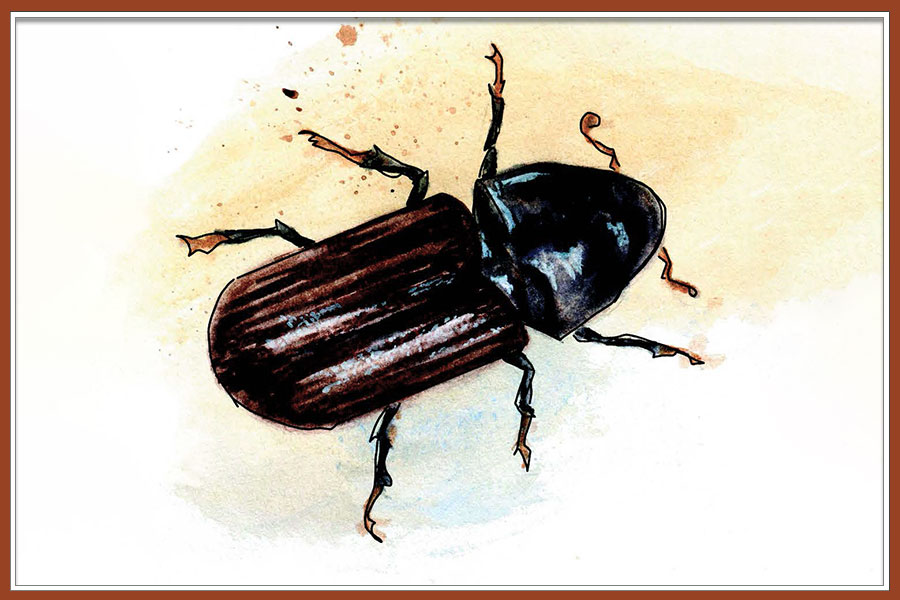[The first round of funding has closed. Click here for information on the second round of funding.]
The mountain pine beetle (MPB) remains a severe threat to Alberta’s pine forests despite the province making positive progress in controlling its spread within the province and aiding in abating the risk to the rest of Canada (Carroll et al., 2017). Alberta was successful in acquiring Federal assistance to pursue three objectives of an operational nature to limit the spread of MPB into the eastern boreal forest, to limit the spread of MPB along the eastern slopes of Alberta, and to mitigate damage to Alberta’s pine resources in locations where MPB is already established. This Research Partnership will be aggressive in seeking new knowledge and innovative management techniques to address these broad objectives.
This Request for Proposals broadly categorizes research needs into strategic themes that are provincially and nationally based and are briefly described here. Within a provincial context, the proposed themes build on the Research Themes that guided the fRI Research Mountain Pine Beetle Ecology Program from 2007 to the present.

Unlike in British Columbia where lodgepole pine has coevolved with Mountain Pine Beetle, Alberta pine is more vulnerable to mortality due to a lack of co-evolution. As the MPB spread eastward through the novel habitats of lodgepole, lodgepole pine – hybrid jack pine and pack pine one can expect to witness unique population dynamics and a range of biological interaction with new hosts. Many uncertainties exist regarding their interaction with novel hosts, fungal associates, natural enemies, and competitors. Moreover, climatic variations will broadly shift our current understanding of biological interactions that will required elucidation to ensure effective operational decisions. Re-exploring MPB biology in eastern habitats is therefore required to understand the risk to eastern pine forests better.

The mountain pine beetle expands its range by spreading through the landscape by short and long-distance dispersal flights. In the extended range, MPB populations are challenged with more heterogeneous pine forests of lodgepole pine, hybrid lodgepole-jack pine exhibiting various degrees of resistance and a vastly different climate than experienced in their historical range. All of these factors affect their dispersal capability and impact population expansion.

Tools to confidently detect the presence of MPB at varying densities are critical to the successful management of populations. Analysis by Carroll et al. (2017) indicates that MPB single‐tree control efforts in homogenous stands in western Alberta were effective at limiting spread. Control efficacy is partially limited by effectively detecting green-attack trees and responding within a given timeframe. Historically, provincial detection efficacy ranged between 54-68 percent (Carroll et al., 2017). Provincially, detection accuracy within the 50 metres concentric survey plot averages 98.5 percent and increases only marginally at increased plot radii.
Management of MPB involves short-term beetle-focused (single-tree treatment) actions and long-term host management strategies that target forest composition at a larger scale. These strategies rely heavily on stand susceptibility models, operational decision support tools, and MPB spread models.

MPB outbreaks cause broad-scale ecological changes in pine forests leading to socio-economic impacts affecting community well-being, safety and security of the forest industry. These changes may be less predictable in the MPB expanded range, but understanding their impact is necessary to develop preparedness and increase community resiliency. Research on the effects of MPB in these new novel habitats is required. Moreover, understanding is needed on the response of endangered species to changes in habitat due to MPB, on hydrologically induced changes across the landscape and on stand regeneration. Research carried out by fRI Research through its Mountain Pine Beetle Ecology Program has provided essential insights to these questions, but more needs to be done. It is essential to incorporate this science-based knowledge into management strategies and to inform future risk assessments.

Studies have shown that tree mortality resulting from MPB infestations affects the susceptibility of stands to fire through changes in fuel loading, fuel structure, and microclimates. Changes in fuel chemistry, e.g., the release of highly flammable terpenoids by dying trees and availability of standing dead trees, can have potentially dramatic impacts on fire behaviour (Jenkins, 2014). Parsons et al. (2014) noted that MPB-killed trees may increase the frequency and intensity of wildfires and contribute to a more rapid spread and a greater likelihood of crown fires (as reviewed by Nealis and Cooke 2012, Parsons et al. 2014). However, many knowledge gaps remain, particularly in light of climate change and the movement of MPB into novel habitats.
The GOA and the Canadian Forest Service are currently collaborating with fRI Research to address Mountain Pine Beetle Effects on the wildfire rate of spread and landscape fire risk and assess existing knowledge gaps. One specific goal of current research related to wildfire is to understand how MPB induced mortality contributes to landscape-level wildfires. This research should continue, given its tremendous value to the provincial FireSmart program as MPB impacts more forested communities.
References for Wildfire Behaviour after MPB
Jenkins, MJ, J.B. Runyon, C. J. Fettig, W. G. Page, and B. J. Bentz. 2014. Interactions among the Mountain Pine Beetle, Fires, and Fuels. For. Sci. 60(3):489–501.
Parsons, R., Jolly, M., Langowski, P., Matonis, M., and Miller, S. 2014. Future Forests Webinar Series. United States Department of Agriculture Forest Service Rocky Mountain Research Station Proceedings, P-70: 19-28. Accessed May 31, 2018.
Nealis, V. and Cooke, B. 2012. Risk assessment of the threat of mountain pine beetle to Canada’s boreal and eastern pine forests. Canadian Council of Forest Ministers. 31 pp.
Preparing a Proposal
Those who plan to submit a research proposal are encouraged to review additional information in references listed below. These references provide provincial and national level descriptions of specific MPB information needs / research needs.
- Anon. 2021. MPBEP Research Prospectus (2007-2021): addressing information needs by the fRI Research Mountain Pine Beetle Ecology Program.
- Rubuliak, N., S. Odsen, and M. Pyper. 2021. DRAFT: Annotated Bibliography for the Mountain Pine Beetle Ecology Program (MPBEP). fRI Research, Hinton, AB. 51 pp. www.friresearch.ca.
- Anon. 2020. A proposal for a Federal/Provincial Partnership to manage mountain pine beetle in Alberta. Alberta Agriculture and Forestry, January 17, 2020. 82p.
- Anon. 2018. Hinton Mountain Pine Beetle Advisory Committee Workplan. June 8, 2018. 27p.
- Bleiker, K. 2019 (Ed.). Risk assessment of the threat of mountain pine beetle to Canada’s boreal and eastern pine forests. Canadian Council of Forest Ministers. 65 pp.
- Cooke, B. and R. McIntosh, 2017. A strategic approach to slow the spread of mountain pine beetle across Canada. Prepared for the Forest Pest Working Group of the Canadian Council of Forest Ministers. 44p.
The Research Proposal
This call for proposals is part of a larger project receiving funding from the Government of Canada, which is subject to Federal Policy requirements on Transfer Payments. Federal government employees and organizations are not eligible for funding or any direct benefits under this call for proposals. Participation of federal employees in research led by other parties is possible under certain conditions and must be assessed on a case-by-case basis. Federal employees must consult with their management team in that regard, and before making any commitment with their collaborators.
Please submit a notification of your intent to submit a proposal as this would allow any periodic updates, if any, to be sent to you directly before proposals are due.
Any proposal that is submitted must contain CERTAIN BASIC ELEMENTS. Content details of the proposal are to be closely followed. Significant variance could result in the disqualification of the proposal. Given that the proposal cannot exceed 4 pages, succinctness is essential.
Proposals must be sent to K. McClain by 3:00PM MST by April 19, 2021. None will be accepted after this date.
Once the proposal is received, it will be evaluated for compliance against the required elements referred to above. Failure to comply with the Requirements of Proposals will result in its rejection.
Provided the proposal succeeds in its primary evaluation, it will be forwarded to the Research Advisory Committee where it will be reviewed for overall quality against the criteria outlined in Proposal Elements. All proponents will be notified of the results of the evaluation by May 24, 2021.
Funding Agencies








